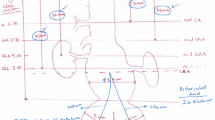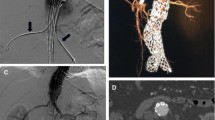Abstract
We aimed to investigate the influences of the sealing length above the renal artery (RA) on gutter formation, non-apposed regions between the aortic wall, stent graft (SG), and chimney graft and incidence of flow channel to the aneurysm in chimney endovascular aortic aneurysm repair (Ch-EVAR) using a juxtarenal abdominal aortic aneurysm model. Neck diameter and length of the silicone model were 24 and 4 mm, respectively. In double Ch-EVAR configuration using Advanta V12, 12 combinations were tested three times with two sizes [28.5 (20%-oversize) and 31 (30%-oversize) mm] of Excluder SG, three sealing lengths above the RA (10, 20, and 30 mm), and two deployment positions (anatomical and cross-leg). Gutter area, non-apposed region, and flow channels to the aneurysm were analyzed using micro-computed tomography. Average gutter area and non-apposed region of 30%-oversize SG were significantly smaller than those of 20%-oversize SG (p = 0.05). Furthermore, the non-apposed region of 30%-oversize SG with a 30-mm sealing length was significantly larger than that of the other sealing lengths. For 20%-oversize SGs, flow channel to the aneurysm was observed, except for the anatomical deployment with the sealing length of 10 mm. For 30%-oversize SGs, flow channel was absent, except for the SG with a 30-mm sealing length in both deployment positions. These flow channels were frequently formed through a valley space, existing in the lower unibody above the two limbs. Our data indicated that the optimal sealing length should be chosen in consideration of the device design difference due to the device diameter in Ch-EVAR.






Similar content being viewed by others
References
Donas KP, Eisenack M, Panuccio G, Austermann M, Osada N, Torsello G. The role of open and endovascular treatment with fenestrated and chimney endografts for patients with juxtarenal aortic aneurysms. J Vasc Surg. 2012;56:285–90.
Schanzer A, Simons JP, Flahive J, Durgin J, Aiello FA, Doucet D, et al. Outcomes of fenestrated and branched endovascular repair of complex abdominal and thoracoabdominal aortic aneurysms. J Vasc Surg. 2017;66:687–94.
Roy IN, Millen AM, Jones SM, Vallabhaneni SR, Scurr JRH, McWilliams RG, et al. Long-term follow-up of fenestrated endovascular repair for juxtarenal aortic aneurysm. Br J Surg. 2017;104:1020–7.
Maeda K, Ohki T, Kanaoka Y, Baba T, Kaneko K, Shukuzawa K. Comparison between open and endovascular repair for the treatment of juxtarenal abdominal aortic aneurysms: a single-center experience with midterm results. Ann Vasc Surg. 2017;41:96–104.
Banno H, Cochennec F, Marzelle J, Becquemin JP. Comparison of fenestrated endovascular aneurysm repair and chimney graft techniques for pararenal aortic aneurysm. J Vasc Surg. 2014;60:31–9.
XiaoHui M, Wei G, ZhongZhou H, XiaoPing L, Jiang X, Xin J. Endovascular repair with chimney technique for juxtarenal aortic aneurysm: a single center experience. Eur J Vasc Endovasc Surg. 2015;49:271–6.
Greenberg RK, Clair D, Srivastava S, Bhandari G, Turc A, Hampton J, et al. Should patients with challenging anatomy be offered endovascular aneurysm repair? J Vasc Surg. 2003;38:990–6.
Moulakakis KG, Mylonas SN, Avgerinos E, Papapetrou A, Kakisis JD, Brountzos EN, et al. The chimney graft technique for preserving visceral vessels during endovascular treatment of aortic pathologies. J Vasc Surg. 2012;55:1497–503.
Mestres G, Uribe JP, Garcia-Madrid C, Miret E, Alomar X, Burrell M, et al. The best conditions for parallel stenting during EVAR: an in vitro study. Eur J Vasc Endovasc Surg. 2012;44:468–73.
de Bruin JL, Yeung KK, Niepoth WW, Lely RJ, Cheung QF, de Vries A, et al. Geometric study of various chimney graft configurations in an in vitro juxtarenal aneurysm model. J Endovasc Ther. 2013;20:184–90.
Niepoth WW, de Bruin JL, Yeung KK, Lely RJ, Devrome AN, Wisselink W, et al. A proof-of-concept in vitro study to determine if endoanchors can reduce gutter size in chimney graft configurations. J Endovasc Ther. 2013;20:498–505.
Mestres G, Yugueros X, Apodaka A, Urrea R, Pasquadibisceglie S, Alomar X, et al. The best in vitro conditions for two and three parallel stenting during endovascular aneurysm repair. J Vasc Surg. 2017;66:1227–35.
Lindblad B, Bin Jabr A, Holst J, Malina M. Chimney grafts in aortic stent grafting: hazardous or useful technique? Systematic review of current data. Eur J Vasc Endovasc Surg. 2015;50:722–31.
Xiong J, Wang SM, Zhou W, Wu JG. Measurement and analysis of ultimate mechanical properties, stress-strain curve fit, and elastic modulus formula of human abdominal aortic aneurysm and nonaneurysmal abdominal aorta. J Vasc Surg. 2008;48:189–95.
Lanne T, Sonesson B, Bergqvist D, Bengtsson H, Gustafsson D. Diameter and compliance in the male human abdominal aorta: influence of age and aortic aneurysm. Eur J Vasc Surg. 1992;6:178–84.
Acknowledgements
This study was supported by the Subsidy Program for Development of International Standards for Evaluation of Innovative Medical Devices and Regenerative Medicine Products, from the Ministry of Health, Labour and Welfare, Japan. The Excluder® was provided by W.L. Gore and Associates.
Author information
Authors and Affiliations
Corresponding author
Ethics declarations
Conflict of interest
Dr. Takao Ohki is a consultant for W.L. Gore and Associates.
Additional information
Publisher’s Note
Springer Nature remains neutral with regard to jurisdictional claims in published maps and institutional affiliations.
Rights and permissions
About this article
Cite this article
Shukuzawa, K., Akaoka, T., Umezu, M. et al. Deployment of stent graft in an excessively higher position above the renal artery induces a flow channel to the aneurysm in chimney endovascular aortic aneurysm repair: an in vitro study. J Artif Organs 22, 200–206 (2019). https://doi.org/10.1007/s10047-019-01090-x
Received:
Accepted:
Published:
Issue Date:
DOI: https://doi.org/10.1007/s10047-019-01090-x




